 Drying Technology
Drying Technology
An important paradigm shift is necessary at multiple levels to advance sustainable sanitation services toward a circular economy in which wastewater is considered a valuable resource rather than a liability. Energy, clean water, fertilizers, and nutrients can be extracted from wastewater—and used to help achieve the SDGs.
In 2018 the World Bank launched the “Wastewater: From Waste to Resource” initiative in the LAC region, to address the wastewater challenge and raise awareness among decision makers about the potential of wastewater as a resource. The initiative also provides guidance on improving the planning, management, and financing of wastewater treatment and resource recovery and promoting the measures needed to make the shift a reality. The initiative has involved a participatory process, including multiple consultations and workshops with stakeholders working on wastewater management projects in the LAC region. The initiative’s findings have been presented and validated at several international conferences, raising awareness of the issue and promoting dialogue among governments, international organizations, and the private sector.
The challenges faced in the LAC region are not unique. The initiative’s final report is published so that countries in the region and around the world can learn from best practices in the sector and promote the paradigm shift toward a circular economy, fostering resource reuse and recovery and ensuring sustainable wastewater management.
Given the increasing interest in and importance of the issue, the World Bank aims to expand this regional initiative into a global one, providing on-demand solutions to implement circular economy principles in wastewater projects worldwide.
Population and economic growth have driven a rapid rise in demand for water resources. As a result, 36 percent of the world’s population already lives in water-scarce regions. Especially in low- and middle-income countries, rapid urbanization has created various water-related challenges, including degraded water quality and inadequate water supply and sanitation infrastructure, particularly in expanding peri-urban and informal settlements.
Only about 60 percent of LAC’s population is connected to a sewerage system, and only about 30–40 percent of the region’s wastewater that is collected is treated. These percentages are surprising given the region’s levels of income and urbanization. They have significant implications for public health, environmental sustainability, and social equity.
By focusing on sustainability, the SDGs are adding a new dimension to the challenges faced in the water supply and sanitation sector. SDG targets for water include improving water quality, implementing integrated water resource management, achieving water use efficiency across sectors, reducing the number of people suffering from water scarcity, and restoring water-related ecosystems. If the LAC region is to achieve the SDGs, the region’s governments will need to significantly increase levels of wastewater treatment.
To improve the wastewater situation in the region, countries are embarking on massive programs to collect and treat wastewater. The investment needs in the water supply and sanitation sector are significant. As cities continue to grow, there is an opportunity to ensure that investments are made in the most sustainable and efficient way possible. Future urban development requires approaches that minimize resource consumption and focus on resource recovery, following principles of the circular economy. Wastewater is and should be considered a valuable resource from which energy and nutrients can be extracted, as well as an additional source of water.

Wastewater can be treated up to different qualities to satisfy demand from different sectors, including industry and agriculture. It can be processed in ways that support the environment—and can even be reused as drinking water. Wastewater treatment frees scarce freshwater resources for other uses or preservation. In addition, by-products of wastewater treatment can become valuable for agriculture and energy generation, making wastewater treatment plants more environmentally and financially sustainable.
Resource recovery from wastewater facilities in the form of energy, reusable water, biosolids, and other resources, such as nutrients, represents an economic and financial benefit that contributes to the sustainability of water supply and sanitation systems and the water utilities operating them. One of the key advantages of adopting circular economy principles in the processing of wastewater is that resource recovery and reuse can transform sanitation from a costly service to one that is self-sustaining and adds value to the economy. Indeed, if financial returns can cover operation and maintenance costs partially or fully, improved wastewater management offers a double value proposition.
The purpose of the report is to share the knowledge created and the conclusions from the initiative with stakeholders and practitioners involved in wastewater planning, financing, and management (including water utilities, policy makers, basin organizations, and ministries of planning and finance) to encourage a paradigm shift in which the value proposition of wastewater in a circular economy is recognized. The report focuses on the LAC region, but many of its findings can be applied to other regions.
The case studies analyzed, workshops with key stakeholders, and lessons learned in the LAC region suggest that four main actions are needed to achieve a paradigm shift in the sector

ACTION 1: Develop wastewater initiatives as part of a basin planning framework to maximize benefits, improve efficiency and resource allocation, and engage stakeholders. There is a need to move from ad hoc and isolated wastewater solutions (such as one treatment plant per municipality) to fully integrated river basin planning approaches, which yield more sustainable and resilient systems. Planning and analyzing water quality and quantity at the basin level makes possible integrated solutions that are more financially, socially, economically, and environmentally sustainable. Basin planning allows for the optimal deployment of facilities and sanitation programs, including the location, timing, and phasing of treatment infrastructure. It enables decision makers to set priorities for investment planning and action. The basin planning framework also allows for more efficient investments, through the design of effluent standards based on the specific contexts of particular water bodies and ecosystems instead of uniform or arbitrary water pollution control standards. Moreover, including wastewater in the hydrological system as a potential water source makes it possible to account and plan for wastewater reuse, limiting incidental and unplanned water reuse that can have negative health and environmental consequences.
ACTION 2: Build the utility of the future by shifting away from wastewater treatment plants to water resource recovery facilities, thereby realizing wastewater's value. Traditionally, treatment focused on removing contaminants and pathogens to recover water and safely discharge it into the environment. To improve sustainability, treatment plants should be viewed as water resource recovery facilities that recover elements of wastewater and use them for beneficial purposes. This process starts with the water itself (which can be used for agriculture, industry, and even human consumption), followed by nutrients (nitrogen and phosphorus) and energy generation. These resources can generate revenue streams for the utility, which can potentially transform the wastewater process from a heavily subsidized one to one that generates revenues and is self-sustainable. To move toward the ideal utility of the future, facilities must be designed, planned, managed, and operated effectively and efficiently. Countries need to recognize the real value of wastewater and the potential resources that can be extracted from it, incorporating resource recovery and circular economy principles in their strategy and investment planning and infrastructure design. Infrastructure is a long-term investment that can lock countries into inefficient and unsustainable solutions. To avoid undesirable lock-in, policy makers need to keep resource recovery in mind when planning wastewater investments.
ACTION 3: Explore and support the development of innovative financing and sustainable business models in the sector. Financing sanitation infrastructure and recovering its costs is a challenge throughout the region. Many utilities do not collect sanitation tariffs that cover the costs of operation and maintenance, not to mention capital investment or future expansion. More efficient subsidies are needed for sanitation, at least during a transition period. The existence of subsidies, however, does not mean that the sector must rely on conventional financing without taking advantage of market conditions and incentives to enhance sustainability. The sector should pursue innovative financial and business models that leverage the potential extra revenue streams from reuse and recovery at wastewater treatment plants.
ACTION 4: Implement the necessary policy, institutional, and regulatory frameworks to promote the paradigm shift. For the paradigm shift to happen, incentives are needed to encourage sustainable wastewater investments that consider reuse and resource recovery and promote circular economy principles. The case studies analyzed show that wastewater projects usually happen in an ad hoc fashion, with no national or regional planning; the enabling factors (including water scarcity and distance to the nearest water source) are often physical and local. To enable the development of these innovative projects, changes in the policy, institutional, and regulatory environment and the proper valuing of water resources are needed. Basin planning efforts in the region need to be strengthened, and governments need to support basin organizations, so that they can improve their technical expertise and exert oversight powers to enforce the implementation of planning instruments. Regulations and standards need to be tailored to the needs of the region and trends in the sector. They need to embrace and promote gradual compliance and foster reuse and resource recovery. Countries in the region need to ensure that they have the required institutional capacity to enforce environmental regulations such as water pollution control standards.
This article is from this page, welcome to click it to read the full content.